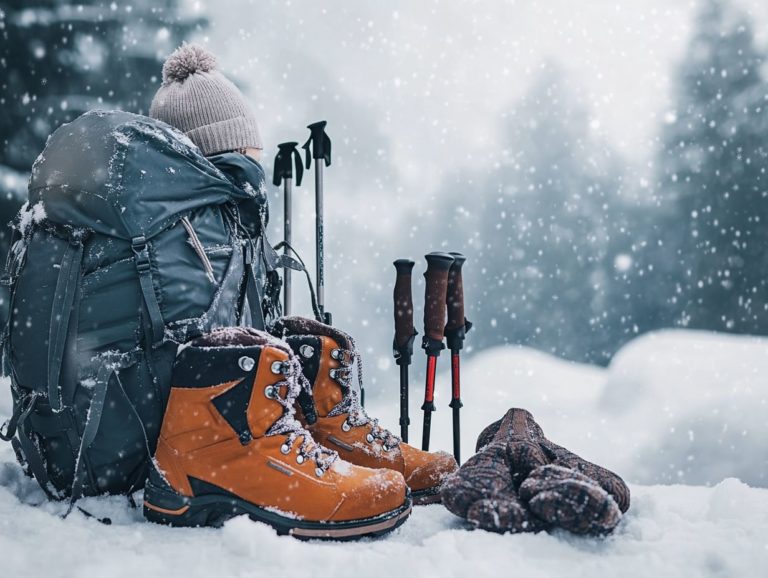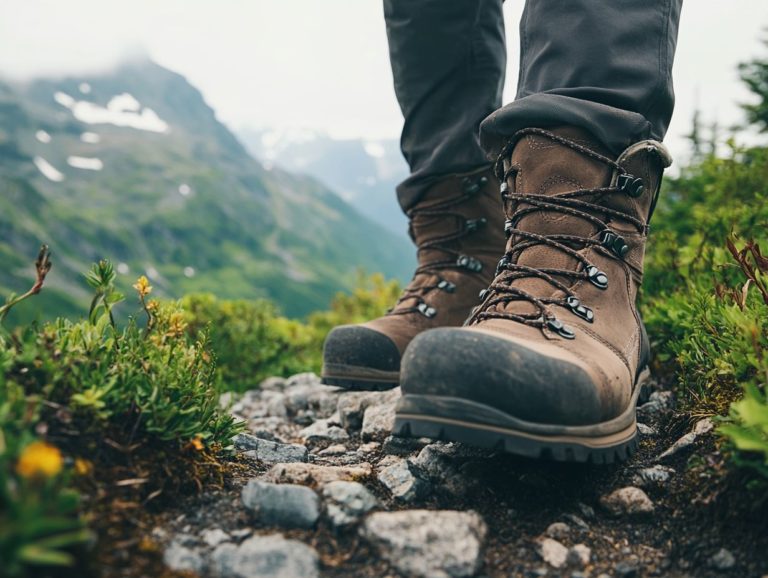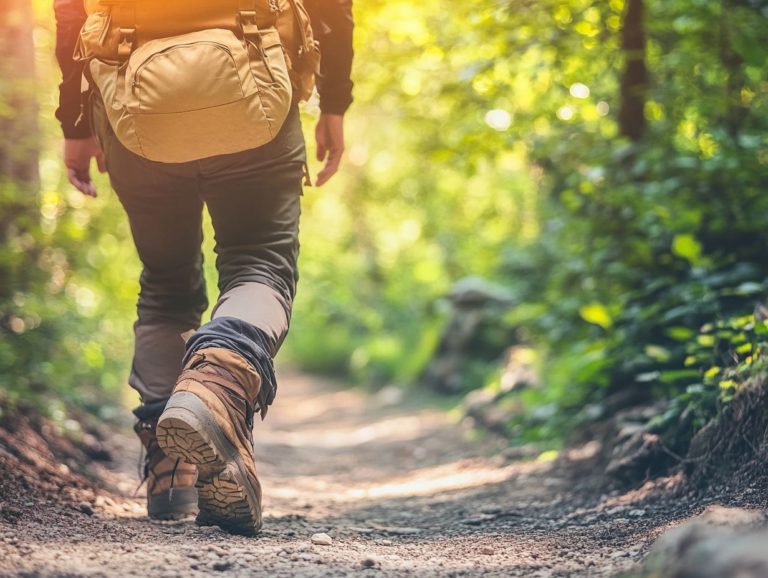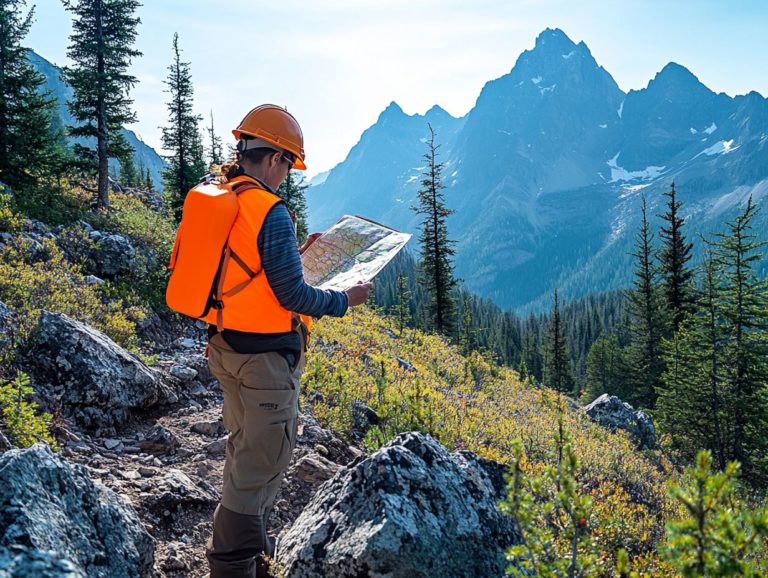How to Choose the Right Hiking Socks
When it comes to hiking, the right gear can truly transform your experience. This includes the often-overlooked socks. Choosing the right hiking socks is essential. The wrong pair can cause discomfort and affect your performance on the trails.
With a myriad of options at your fingertips, understanding the significance of factors such as material, fit, and terrain is vital. This article explores the importance of selecting the perfect hiking socks. You’ll discover the exciting types available, care tips to prolong their life, and solutions for common sock-related dilemmas.
Prepare to elevate your hiking adventures to new heights, whether you’re on the Appalachian Trail or the Long Trail!
Contents
Key Takeaways:
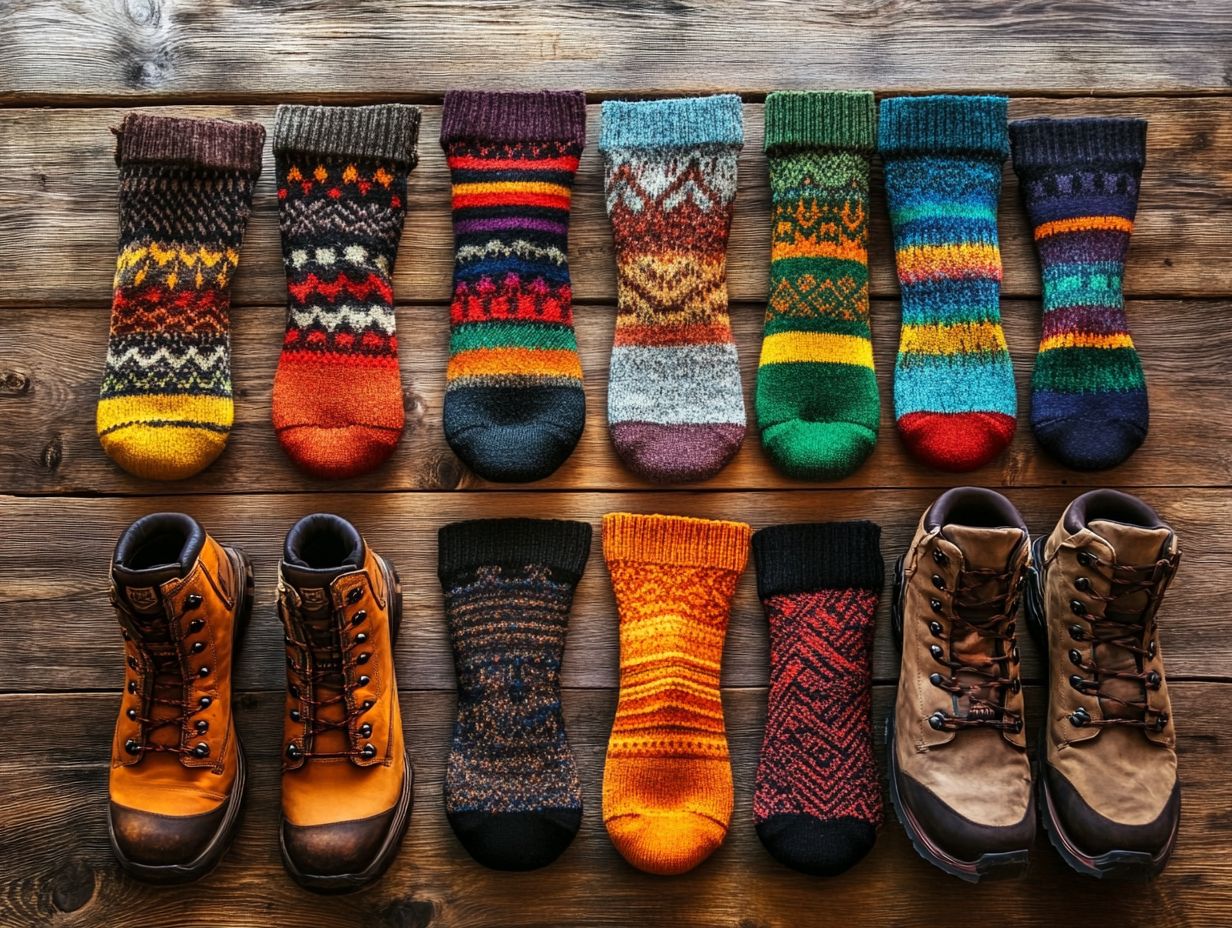
- Invest in the perfect hiking socks to ensure comfort and performance. Consider sock types and features that suit your adventures.
- Think about factors like material, fit, and weather when making your choice. Merino Wool and Coolmax fibers offer fantastic benefits!
- Take good care of your socks by washing and storing them correctly. This ensures they last longer and help prevent issues like blisters.
Importance of Choosing the Right Hiking Socks
Selecting the right hiking socks is essential for a truly enjoyable outdoor experience. A variety of options is available, such as Darn Tough socks crafted from Merino Wool and Coolmax fibers. Finding the ideal pair is key to effective moisture management and maintaining stable body temperature.
High-quality hiking socks elevate your journey with cushioned comfort, durability, and odor resistance. This ensures that every adventure on the trail, whether along the Appalachian Trail or through Vermont’s stunning landscapes, is nothing short of delightful.
Factors to Consider when Choosing Hiking Socks
When selecting hiking socks, consider several factors to guarantee an exceptional hiking experience. Focus on the material, construction, fit, and cushioning of the socks.
The right pair can profoundly influence your adaptability to changing weather conditions and diverse terrains on your hikes.
Material and Construction
The material and construction of your hiking socks are essential for maximizing comfort and performance on your adventures. Opting for Merino Wool and Coolmax fibers can greatly enhance your experience, thanks to their moisture-wicking and odor-resistant qualities.
Merino Wool stands out for its natural ability to manage moisture, effortlessly absorbing sweat while keeping you feeling dry perfect for long treks in fluctuating temperatures. In contrast, Coolmax fibers excel in breathability, ensuring your feet remain cool and dry, especially when the weather heats up.
Beyond the choice of fabric, the construction of hiking socks matters too. Features like reinforced heel and toe areas boost durability, providing a tailored fit that reduces the likelihood of blisters. Breathable materials become crucial in safeguarding against overheating and moisture buildup. This allows you to concentrate on the journey ahead whether you’re navigating humid forests or tackling chilly mountain trails.
Fit and Cushioning
Achieving the perfect fit and cushioning level in your hiking socks is crucial for preventing blisters and ensuring comfort throughout your adventure.
The right pair of socks can transform a demanding trek into a delightful experience, allowing you to immerse yourself in breathtaking views rather than focusing on discomfort. Additionally, understanding how to choose the right hiking trail is essential for ensuring a comfortable journey. Look for features like moisture-wicking materials that keep your feet dry, and strategic padding in high-impact areas to enhance protection against rugged terrain.
If you’re planning longer hikes, opting for extra cushioning can be advantageous, while lightweight options are ideal for day hikers who prioritize agility.
A snug fit around your arch and ankle not only promotes stability but also minimizes the risk of sock slippage, which can lead to irritation. By understanding these nuances, you can select the perfect sock that complements your unique hiking style, elevating your outdoor experience to new heights.
In conclusion, choosing the right hiking socks is vital for enhancing your outdoor adventures. Understanding the importance of good socks for hiking can help you make informed choices and enjoy every step of your journey!
Weather and Terrain
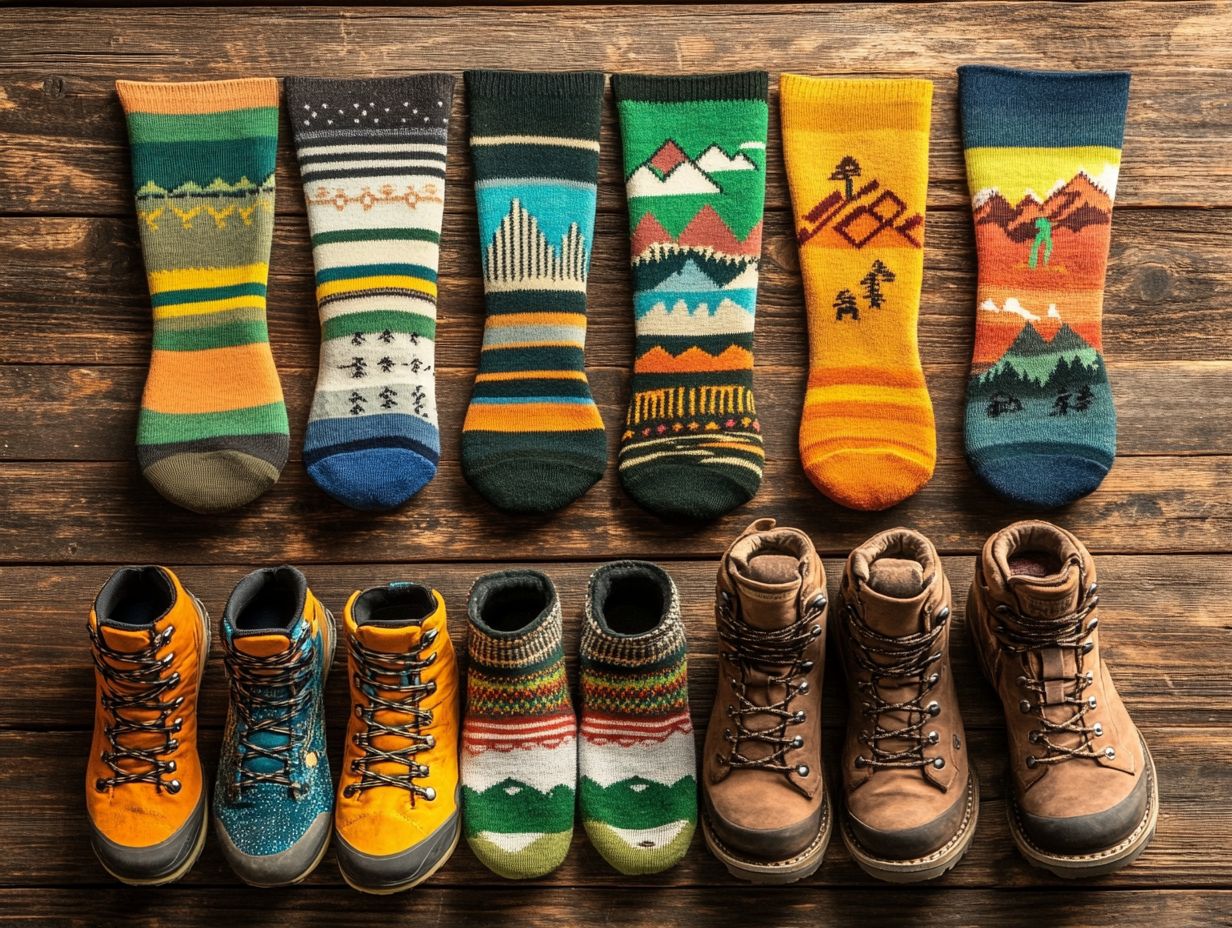
When you re choosing hiking socks, it’s essential to consider the weather, terrain, and your preferred hiking styles you will encounter. These factors will guide you in selecting the right sock height and weight for your adventure.
For instance, if rain is in the forecast, materials that wick away moisture are your best bet to keep your feet dry. In snowy conditions, you will want thicker, insulated socks that offer warmth and cushioning.
On those sweltering days, lightweight, no-show or low-cut socks can boost breathability and help prevent blisters.
The decision between micro crew and boot socks also hinges on the height of your boots and the nature of the terrain. Higher cuts are beneficial for keeping debris out while ensuring warmth in cooler climates. By choosing the correct sock weight midweight for moderate hikes or heavyweight for more rugged trails you can significantly enhance your comfort and performance on the trail.
Types of Hiking Socks
In terms of hiking socks, you will find a range of options tailored to your unique preferences and the conditions you face on the trail. From Low Cut to Mid Cut and High Cut designs, each type serves a specific purpose to enhance your outdoor experience.
Brands like Darn Tough provide an impressive collection, ensuring you have the right pair for every adventure.
Low Cut vs Mid Cut vs High Cut
Low Cut, Mid Cut, and High Cut hiking socks each have unique purposes tailored to different hiking styles, ensuring your feet remain well supported and comfortable on the trail. Understanding the distinct advantages of each sock type can significantly elevate your outdoor experience.
Low Cut socks are perfect for warm-weather hikes where breathability is key, offering a lightweight feel while effectively managing moisture. Mid Cut socks strike a balance between coverage and ventilation, making them ideal for moderate treks; they provide extra ankle support without compromising comfort.
When tackling challenging terrains or braving colder climates, High Cut socks become your best ally. Their extended height shields against debris and offers added warmth, which is crucial for those longer excursions. By aligning your sock choices with your specific hiking plans, you can truly optimize comfort and performance across various trails. Additionally, consider how to choose the right sunglasses for hiking to protect your eyes during those adventures.
How to Properly Care for Hiking Socks
Taking care of your hiking socks is essential for your comfort and performance on the trail! Caring for your hiking socks is crucial to preserving their durability and performance, ensuring they accompany you on countless adventures while remaining odor-resistant.
Washing and Drying Techniques
Wondering how to keep your hiking socks in top shape? Washing and drying your hiking socks correctly is essential for preserving their features and ensuring they last. Improper care can lead to a decline in performance and comfort, and you certainly don t want that.
To maintain the integrity of materials like Merino Wool, a natural fiber known for its warmth and breathability, and Coolmax, a synthetic fiber that effectively wicks moisture away, it s crucial to use gentle washing techniques. Opt for a cold, delicate cycle and a mild detergent that won t strip away those natural oils or synthetic properties. Steer clear of fabric softeners, as they can mess with moisture-wicking capabilities. Always wash your socks inside out to minimize friction and pilling.
In terms of drying, air drying is the way to go. Lay them flat or hang them up in a shaded area to avoid shrinkage or damage. For optimal care, consider washing them after every few wears especially if you ve been hiking in damp conditions to prevent odor and bacteria that can cause odors.
Storage and Maintenance
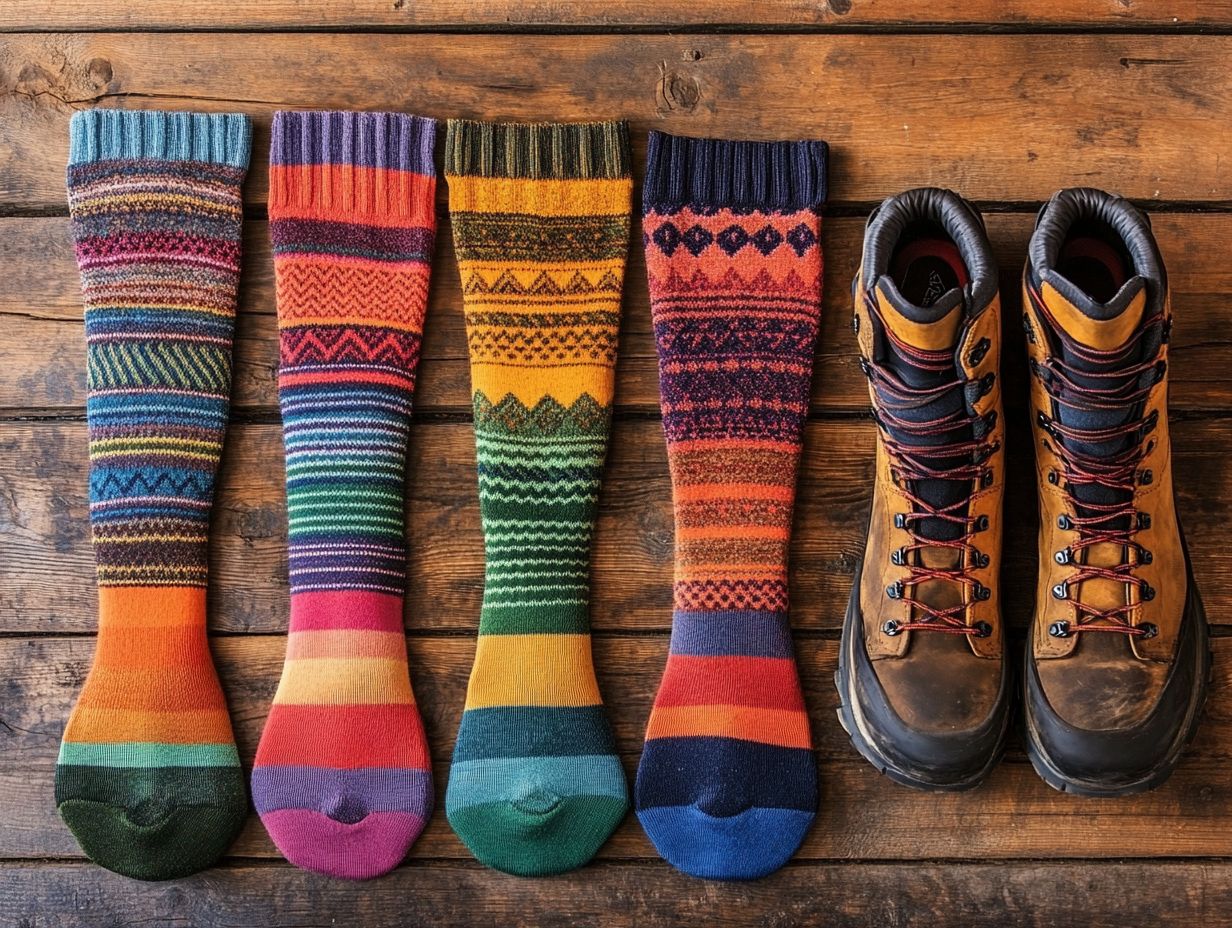
Proper storage and maintenance of your hiking socks can greatly enhance their durability, ensuring they are always primed for your next outdoor adventure.
Keeping them in a cool, dry spot is essential to prevent mold growth and unpleasant odors, both of which can spoil even the finest hiking gear. When socks are damp or stored incorrectly, it not only impacts their hygiene but also compromises the comfort they offer during your treks.
Regularly inspecting for signs of wear and tear, such as thinning fabric or small holes, is vital in identifying which pairs need to be replaced. Caring for the specific materials be it wool, synthetic fibers, or blends will extend their lifespan and keep them performing at their peak on the trails.
Troubleshooting Common Sock Issues
Addressing common sock issues like blisters, hot spots, and odor can significantly enhance your hiking experience. By troubleshooting these concerns, you enable yourself to make informed choices when selecting your future hiking socks. This ensures that every step you take is as comfortable as possible.
Blisters and Hot Spots
Blisters and hot spots are common hiking sock issues that can derail your adventure. Poorly fitting socks can lead to friction, which turns sensitive areas into painful blisters, distracting you from the beauty around you.
To keep these nuisances at bay, seek out socks crafted from moisture-wicking materials that keep your feet dry, along with targeted cushioning in high-impact zones. Choosing socks with seamless construction can significantly reduce irritation, enhancing your overall comfort on long treks.
High-quality hiking socks can transform your outdoor adventures. They are tailored to your specific foot shape, allowing you to fully enjoy every step of your journey.
Odor and Moisture Control
Odor and moisture control are crucial for your comfort during long hikes. Choosing materials like Merino Wool provides natural odor resistance and exceptional moisture management. Additionally, materials like Coolmax fibers aid in temperature control.
Keeping your feet dry is key to preventing unpleasant smells. Investing in quality socks is essential. Merino wool, along with synthetic fibers like Coolmax and nylon, excels at wicking moisture away from your skin while regulating temperature, making them perfect for various weather conditions.
When selecting socks, look for features that include:
- Mesh panels for breathability
- Arch support for extra comfort
- Cushioned comfort to help prevent blisters
In warmer climates, lightweight moisture-wicking socks will serve you best. Conversely, thicker, insulated options are ideal for colder environments, helping you maintain warmth without compromising odor control.
Frequently Asked Questions
What are the important factors to consider when choosing hiking socks?
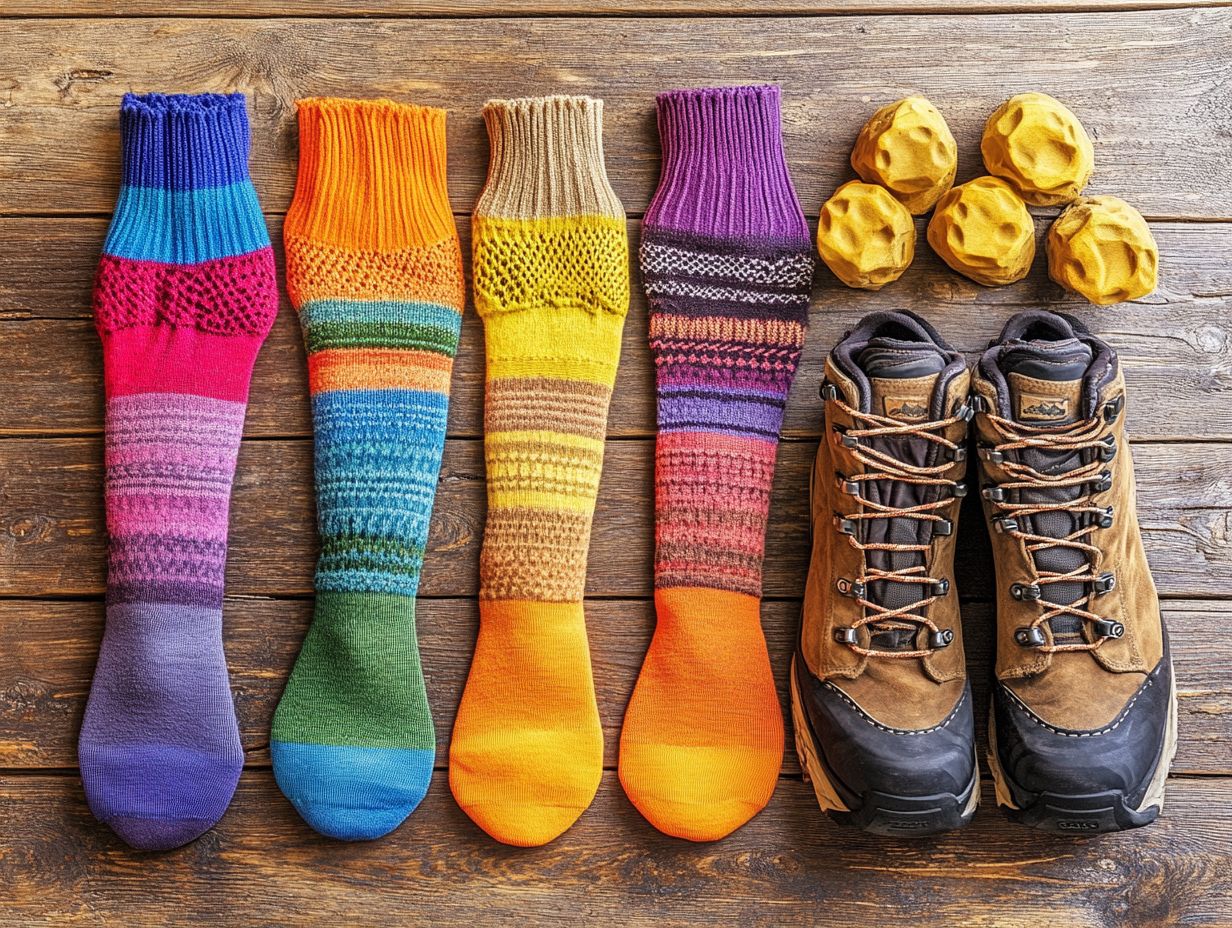
Consider material, cushioning, fit, and moisture-wicking properties for comfort.
What materials are best for hiking socks?
The best materials for hiking socks are usually a blend of synthetic fibers like polyester or nylon and natural fibers like merino wool. These materials offer durability and moisture-wicking properties to keep your feet dry and comfortable during long hikes.
Should I choose thick or thin hiking socks?
The thickness of hiking socks depends on personal preference. Generally, thin socks are recommended for warm weather hikes, while thick socks are better for colder weather. Consider the level of cushioning and protection you need for your feet when making your choice.
How should hiking socks fit?
Hiking socks should fit snugly without being too tight or too loose. They should also have enough elasticity to prevent slipping or bunching during your hike. It’s best to try on different sizes and brands to find the perfect fit for your feet.
Are special features like arch support necessary in hiking socks?
Special features like arch support and cushioning can provide extra comfort and support for your feet during long hikes. They may not be necessary for everyone, but if you have foot issues or are planning a challenging hike, it may be worth investing in socks with these added features.
When Should You Replace Your Hiking Socks?
It’s time to replace your hiking socks if they lose their shape, elasticity, or cushioning. Look for holes or signs of wear, as these indicate it s time for a new pair.
As a general rule, consider replacing your hiking socks after every 500 to 1,000 miles of use. Keeping your socks in good condition can enhance your comfort and performance on the trail!


